Kuuki ninja at the second generation (Tangband 8cm Paper corn
W3-593SD)
The Kuuki ninja is being reformed.
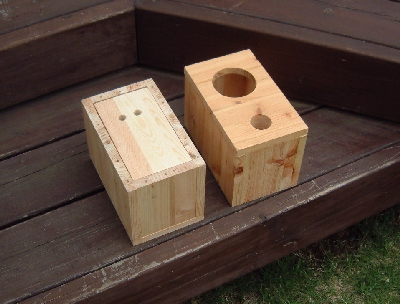
The eternal theme since Nagaoka Tetsuo where a rich bass sound
is achieved with a small
speaker : I 've thought for a long time that it was possible to
achieve it with positive
current feedback vented system.
However, the vented system with rubber edge unexpectedly
produces rich bass sounds.
So I declare that it succeeded to the name of the Kuuki ninja at
second generation.

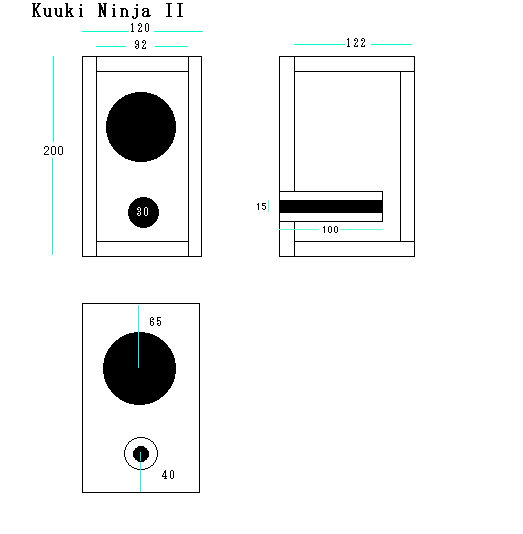
Explanation
Inner capacity 1.4L , 1.5cm in diameter of duct , 10cm in length
At a glance this seems to be a metal corn , but is a paper corn.
To lower the fb, a wooden
duct of 10cm in length 1.5cm in the diameter was bonded.
This is ,in a word, a speaker of low fb that not is in my
works before.
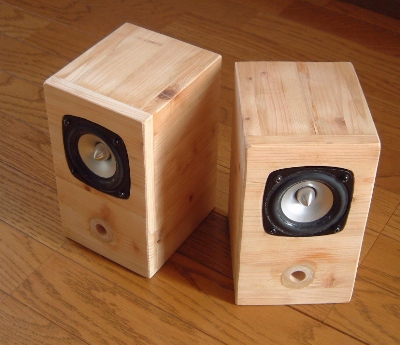
The Kuuki Nnja at the second generation
Usual way, step cutting is indispensable on apparance. Trimmer
and "scallop" was used.
Data
This unit is W3-592SD though the table shows W3-593S. Thi is ,in
a word, with a die-cast frame
version.Further data of W3-592SD are uncertain.
| |
18W/8546 |
W3-315D |
W3-593S (paper cone)
|
W11CY-001 |
W14CY-001 |
W17E-002 |
CA11RCY |
| Qts |
0.21 |
0.52 |
0.79 |
0.34 |
0.36 |
0.32 |
0.3 |
| Vas (L) |
70 |
1.7 |
1.3 |
3.7 |
10.6 |
29.5 |
4.6 |
| Fs (Hz) |
25 |
105 |
100 118 |
65 |
43 |
34 |
53 |
| Re (ohm) |
5.5 |
6.6 |
6.6 7.3 |
5.7 |
5.4 |
6.4 |
5.5 |
| Le (mH) |
0.4 |
0.2034 |
0.3165 |
0.32mH |
0.37mH |
0.4mH |
0.65 |
| Xmax (m) |
6.5/10 |
1mm |
0.4mm |
6/9mm |
8/14 |
8/19 |
6/9 |
| Z (ohm) |
8 |
8 |
8 |
8 |
8 |
8 |
8 |
| Qms |
2.91 |
5.51 |
7.76 5.5 |
1.79 |
1.80 |
2.4 |
2.1 |
| Qes |
0.23 |
0.57 |
0.88 |
0.42 |
0.44 |
0.37 |
0.35 |
| SPL dB/W(m) |
89 |
87 |
86 |
86 |
87 |
87 |
85 |
| Pe (W) |
|
|
|
|
|
|
|
| BL |
8.3 |
3.89 |
3.3 |
5.6 |
5.8 |
7.8 |
6.0 |
| dia (m) |
|
|
|
|
|
|
|
| Sd (m^2) |
|
|
|
50 |
75 |
126 |
50 |
| mo (g) |
18.5 |
2 |
1.96 |
5.5 |
9.6 |
15.5 |
6.8 |
| no (%) |
|
|
|
|
|
|
|
| Rp (Ω) |
67 |
70.3552 |
64.5693 |
32 |
31 |
42 (42.8) |
35.3 |
| frequency response |
|
105-20k |
100-20kHz |
|
|
|
|
| Zo (Ω) at Qtc=0.56 |
|
|
|
|
|
|
|
Measurement
High impedance sweep
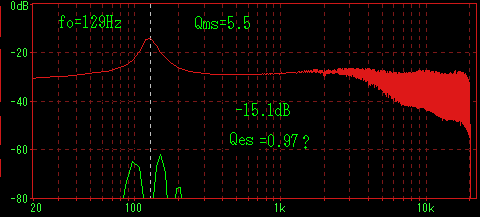
fo=129Hz
Qms=5.5
Actual Qms might be larger when thinking about accuracy in the
vicinity of fs.
Electromagnetic damping sweep

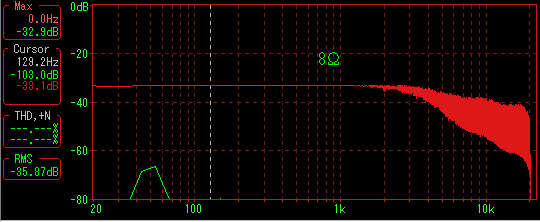


Qts=0.6
It goes down to about 0.4 when the negative impedance amplifier
is used.
Vas is obtained.
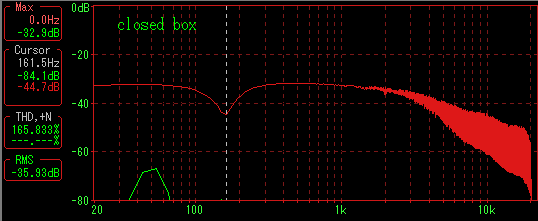
129Hz --> 161Hz
Vas=0.78L
Because there is an air leakage for this unit from the equalizer
though this has gone out low
It cannot be said that this is correct.
The peak in closed box.
It is understood that Q has changed around 170Hz. In any system
this change of Q happens
, so the metrology not to be able to see this change is no good .

There is a distortion by the nonlinearity of the air spring in
the closed box baffle.
The distortion is improved by the current positive feedback.
The box is examined.
Z=0ohm
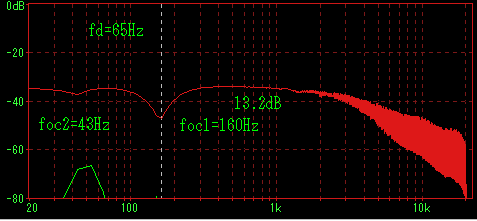
Zo=-3ohm

The frequency response
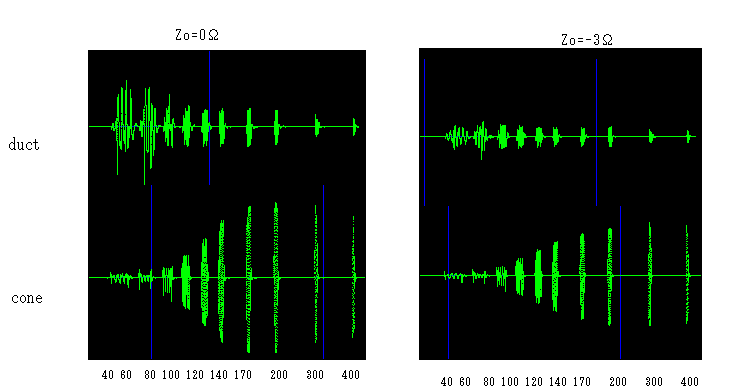
There is no feeling that a low sound is insufficient in an actual
audition at all. It is a very rich
bass sound.
The difference between rubber and the cloth might be able to be
understood if it thinks by the bungee jumping.
Nearfield response
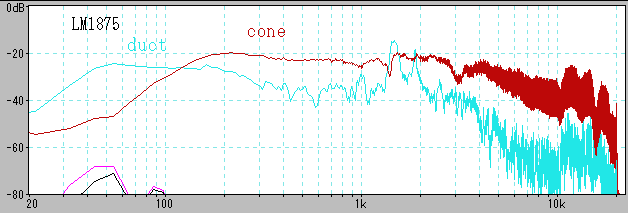
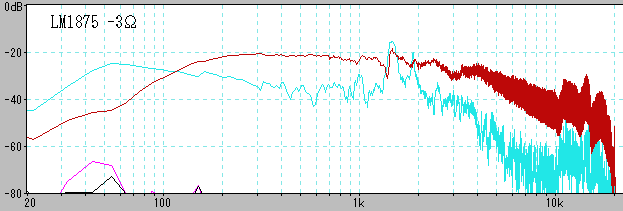
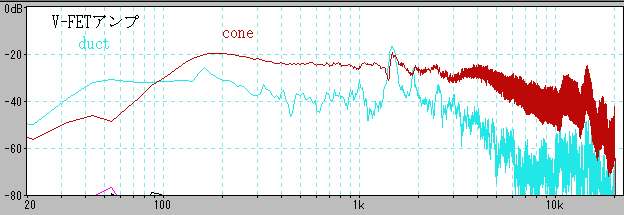
Cosine wave analysis

Voltage and current analysis

MFB is observed in the tail of the wave. The first wave speed is
sure to have gone out
little and low. The current flows almost, disappears, and shifts
to one slightly when the
speed goes up.
Voice coil movement after signal cutting off
Voice coil verosity after the signal cut-off can be seen by
detecting the current wave.
By this wave form , Q in fco1 is estimated .Effect of the current
positive feedback
is also seen.
The white line shows the point of signal cutoff. It is accurate
because it is recorded simultaneously with the voltage.


Power collapse test

There is a stability in the negative impedance amplifier. Is it
campy in the way of the collapse
when in the electromagnetic damping amplifier? It seems to
balance barely. In addition, the
figure that has returned after it collapses to one's heart's
content is there when observing it.
. This might be a control magic of rubber.
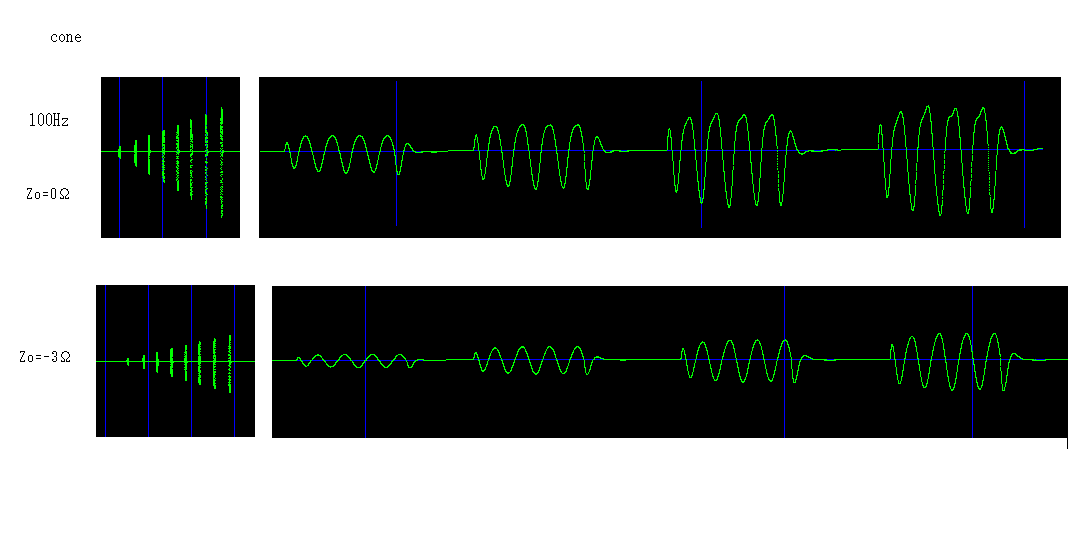
The distortion has decreased in the negative impedance amplifier.
Referring FE83E vented system which has cloth edge
It is very interesting when seeing thus.
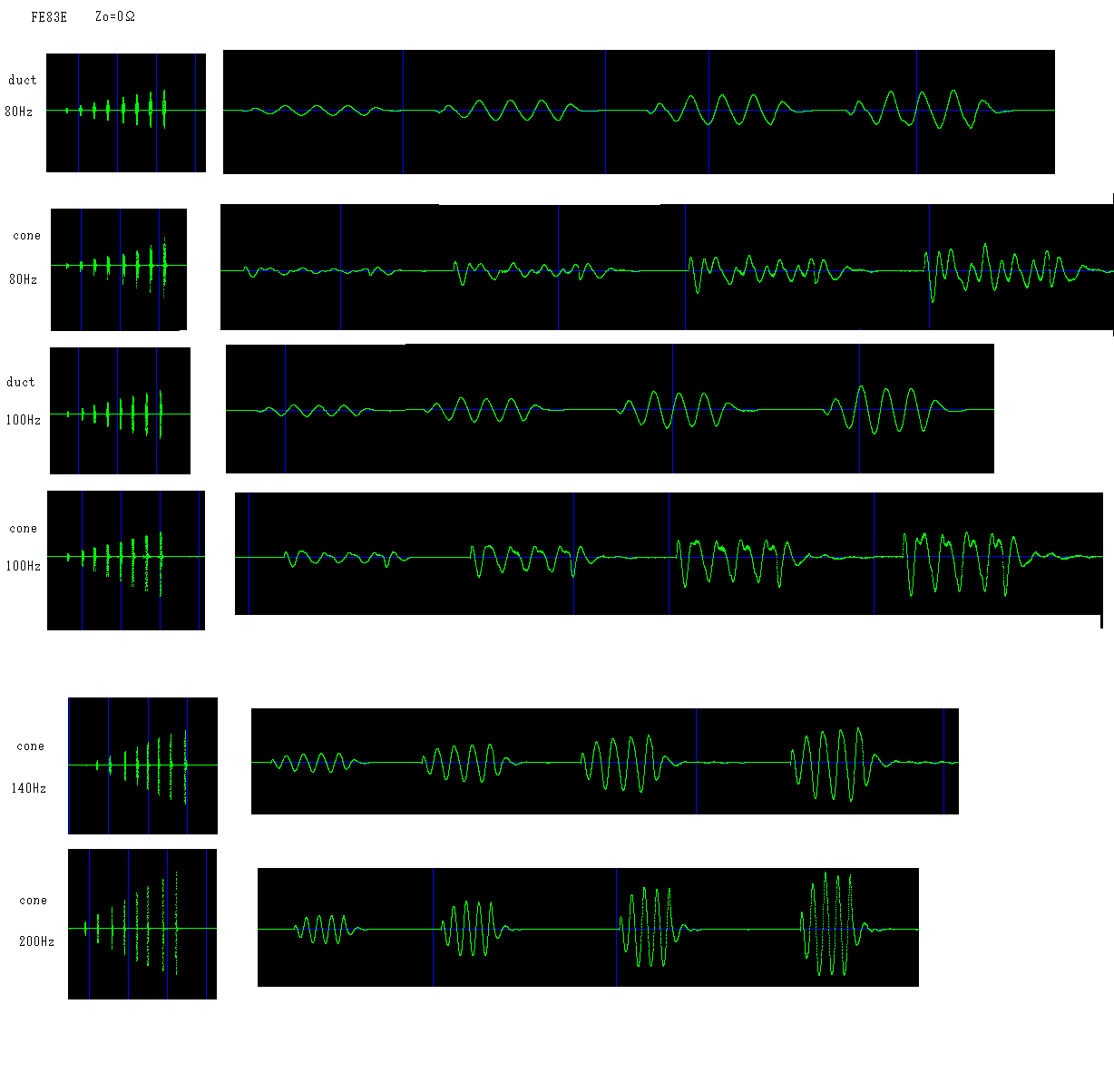
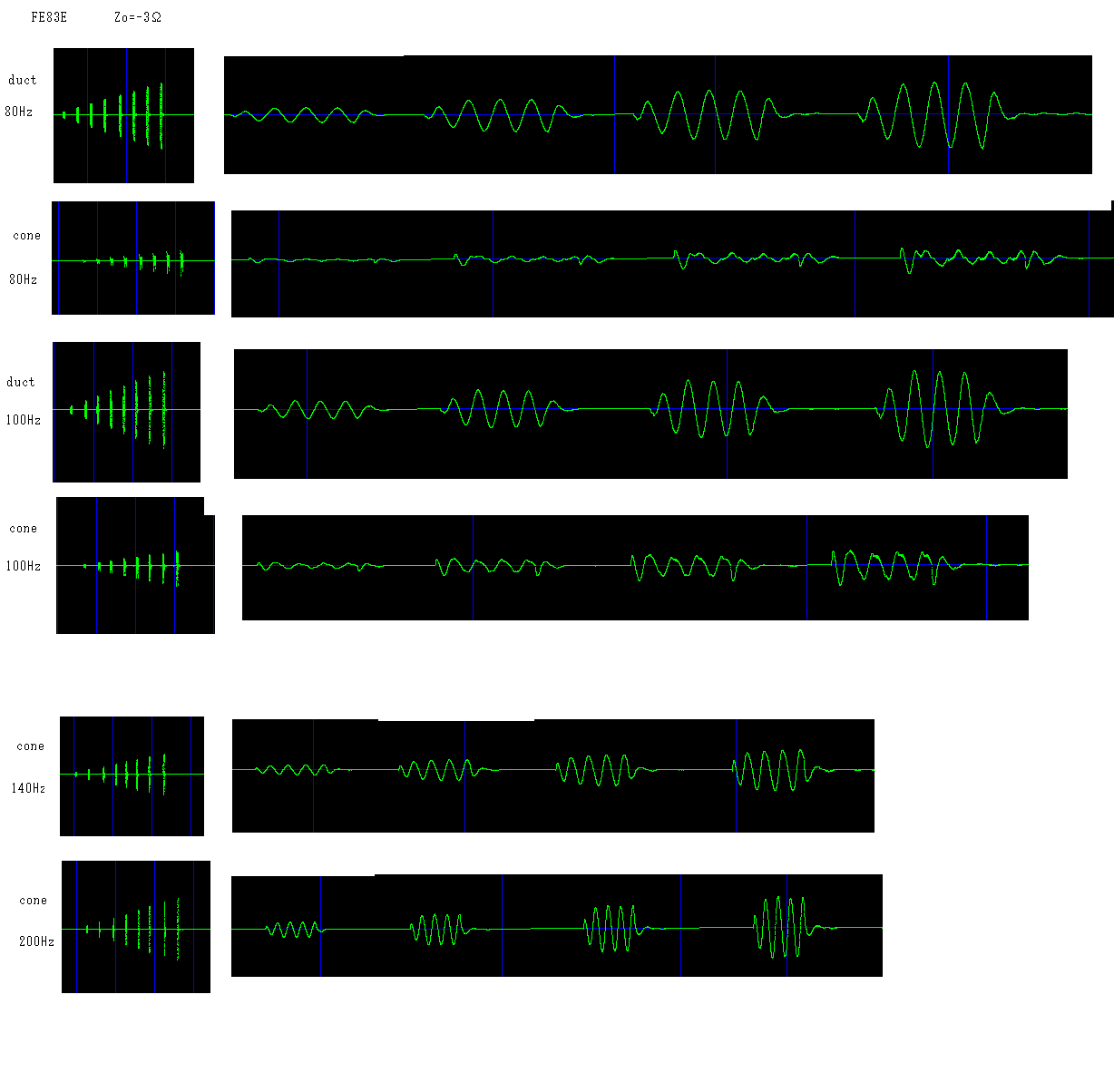
Movement of corn is violent in 80Hz and 100Hz, the allophone is
originated, and it is
clear when becoming 200Hz. It is improved a little in -3ohm.
The duct resonates clearly at low frequency . The sound pressure
of the duct tends to be
higher than the sound pressure of cone in -3Ω.
The duct resonates less by the character of the cloth edge, and
the sound pressure of corn is distorted.

It distorts mellow even if reaching critical limit. It gives
birth to the sound pressure with high energy of the rubber power.

























